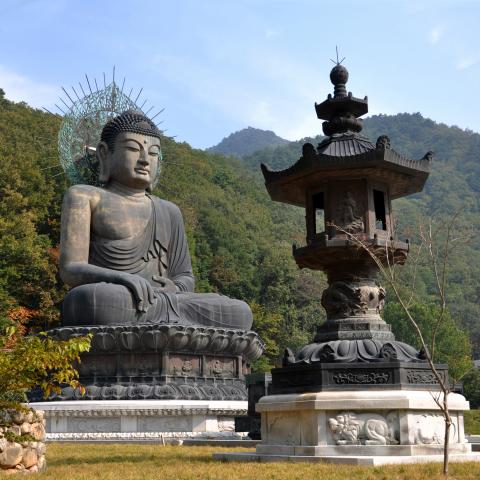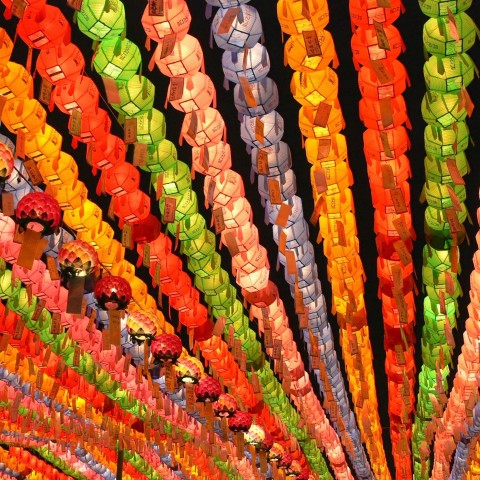In South Korea, Buddha’s Birthday is a major celebration dedicated to honoring the birth of Buddha, clearing one’s mind, and performing good deeds. In this article, you’ll learn all about Buddha’s Birthday celebration in South Korea, a little bit of the country’s religious background, and pick up some useful vocabulary.
Let’s get started.

1. What is the Buddha’s Birthday?
South Korea doesn’t have a national religion. South Korea contains a mix of different religions, including Buddhism, Christianity, and Catholicism. Buddhism does remain a very common religion here, and the Buddha’s Birthday is the most important Buddhist holiday.
The Korean Buddha’s Birthday holiday is celebrated in honor of the day when Sakyamuni, or Buddha, came to this world. The beginning of Buddhism, or 불교 (bulgyo), can be traced back to 37 B.C., when the ancient Korean kingdom of Goguryeo made it the national religion. Buddhism was the most prominent religion in Korea up until Christianity’s more recent introduction to the country.
Did you know there’s another name for Buddha’s Birthday in Korean? It’s Seokga Tansinil. Seokga is “Buddha,” and Tansinil is Chinese for “the day of birth.” Just remember that these are the same terms.
-
→ If you want to learn more vocabulary related to religion, study our Religion vocabulary list!
2. When is Buddha’s Birthday?
This holiday takes place on the eighth day of the fourth month of the lunar calendar, meaning that the date of Buddha’s Birthday celebration varies from year to year on the Gregorian calendar. For your convenience, here’s a list of this holiday’s date for the next ten years.
- 2020: May 7
- 2021: May 26
- 2022: May 15
- 2023: June 2
- 2024: May 22
- 2025: May 12
- 2026: May 31
- 2027: May 20
- 2028: May 9
- 2029: May 27
3. How is Buddha’s Birthday Celebrated in Korea?
The Buddha’s Birthday celebration in South Korea consists of various events and traditions, the most common of which is the 연등행사 (yeondeung haengsa), or Lotus Lantern Festival. The “lotus” lanterns are so-called because they’re shaped like lotus flowers. During this festival, people usually write a wish or two on a piece of paper, put this paper into the lantern, and then light the lantern and hang it up inside the temple.
On Buddha’s Birthday, South Koreans enjoy visiting a Buddhist temple, or 절 (jeol), most of which are located somewhere in the mountains. In addition to the Lotus Lantern Festival, people also enjoy a delicious vegetarian meal called Sachal Bibimbap. This is similar to the normal bibimbap—made with rice, red pepper paste, veggies, and meat—except it lacks the meat. This type of bibimbap is made with fresh-grown vegetables. Abstaining from meat on Buddha’s Birthday represents the clearing of one’s mind.
-
→ To learn more about what to expect from food in Korea, check out our list called What’s Your Favorite Korean Food?
4. Back to the River
On the Buddha’s Birthday, Koreans often bring turtles or fish to the river. Do you know why this is?
This tradition is called 방생 (bangsaeng), meaning “release of captive animals.” This usually refers to the act of releasing pet fish or turtles back into nature, and two of the most popular places to do this are the Han River and Cheonggyecheon Stream.
-
→ Study our Marine Animals vocab list for some more useful words.
5. Must-Know Vocabulary for Buddha’s Birthday
Ready to review some of the vocabulary words from this article? Here’s a list of the most important words and phrases for Buddha’s Birthday!
- 불교 (bulgyo) — “Buddhism”
- 인도 (indo) — “India”
- 태어나다 (taeeonada) — “be born”
- 부처님 오신 날 (Bucheonim oshin nal) — “Buddha’s Birthday”
- 석가모니 (seokgamoni) — “Buddha”
- 불상 (bulsang) — “statue of the Buddha”
- 방생 (bangsaeng) — “release of captive animals”
- 연등행사 (yeondeung haengsa) — “Lotus Lantern Festival”
- 해인사 (haeinsa) — “Haeinsa temple”
- 절 (jeol) — “Buddhist temple”
- 스님 (seunim) — “Buddhist Priest”
To hear the pronunciation of each word and phrase, and to read them alongside relevant images, be sure to check out our Korean Buddha’s Birthday vocabulary list!
Final Thoughts
We hope you enjoyed learning about Buddha’s Birthday with us, and that you learned something new about Korean culture and society.
Do you celebrate Buddha’s Birthday in your country? If so, how do your traditions differ from those in Korea? We look forward to hearing from you.
To continue delving into Korean culture and the language, KoreanClass101.com has more articles you may enjoy:
- Gwangbokjeol: Celebrating Independence Day in Korea
- Chuseok: How to Celebrate Korean Thanksgiving Day
- 10 Korean Hand Gestures You Need to Know
- Essential Korean Language for Travel You Must Know
- The Top 100 Korean Adjectives You Must Know
That should be enough to keep you busy for a while, but if you want even more great content on all things Korean, create your free lifetime account today. With tons of fun and effective lessons for learners at every level, there’s something for everyone!
Happy learning. 🙂















